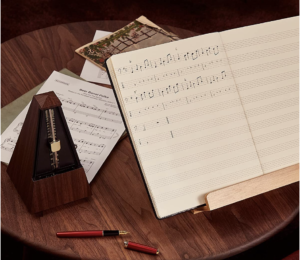How To Self-correct Your Violin Playing With Video
Want to see faster progress in your violin journey and you feel like you’re just a little bit stuck not knowing what to do? My first question for you is, “Are you Self-correcting With Video?” This is the fastest way for you to progress by self-correcting.
In this post, I’ll be giving you tips on how to Self-correct With Video, use video allowing you to play better, progress faster, and overcome performance anxiety. Pretty cool, huh?
Recording for progress
Video is such a great tool and it’s at our fingertips. Just with our iPhone or smartphone, we’re able to record ourselves with video and audio. It’s your choice you can use voice memos and record yourself playing the violin with audio, to listen to the sound that you’re producing or better yet, you can use your camera app and record yourself via video.
Video is a powerful tool
Video is wonderful because you can actually see yourself playing. You can see if there are some improvements that you need to make in your left-hand setup or in your right-hand setup. You can also see if your bows are going straight. When you hear something you don’t like you can see exactly what happened in the moment that happened in order to pinpoint why it happened.
Self correcting with video allows awareness to be present
As violinists, it’s difficult to be aware while playing, especially if you are in the beginner stages or an intermediate violinist, or returning after a long period of time. If you’re just playing the violin and not observing yourself, it’s truly difficult to find out what needs to be improved upon if you’re not seeing what exactly is going on and what’s causing the problems.
Practice playing with the recorder on
So the first step in using video to play better and to overcome performance anxiety is to actually record yourself. If you have a fear of recording yourself, especially watching or listening to yourself, this is the best way to have you overcome that fear.
You may have so much fear that you just don’t even want to record yourself. So in order to kind of get yourself desensitized, have your phone with you in your practice room, in your practice session and just hit record for that video multiple times and you don’t even have to watch it.
You can wait two days later if you need to, to watch the video or you could just delete it and just record yourself and then delete it without watching. Record yourself and delete. This way get used to playing for the recorder.
At the very beginning, you don’t even have to publish the video anywhere. You don’t even have to watch the video yourself. If you want to just break into the recording of your violin playing gently by practicing hitting the record button and playing because there is such a different feeling knowing that you’re being recorded as you’re playing than if you’re not being recorded as I’m sure you know.
Video record daily
I would suggest video recording on a daily basis. Every time you practice the violin, have your phone there and take a quick recording. Now this doesn’t have to be on an entire concerto or three pages or even one page you could just record two measures or five notes that you’re listening for and wanting to know what’s going on.
Perhaps there’s a measure in your piece that’s just not going well. You sound bad every single time you play that measure. Then record yourself so you can see what exactly is going on.
You are the observer
Once you do have the desire to watch your recording, it’s great to put yourself in a specific mindset and that mindset is you are observing somebody else. This is not you. Detach yourself from what you’re seeing on the recording. Detach yourself emotionally and watch the recording with diagnostic tools to help you improve or to help the person in the recording improve. Think of it as somebody else. Perhaps you’re the teacher, the recording is your student and what advice would you give this person to improve that specific area?
What to look for
First, you can investigate the left hand. How is the left hand working in that area? Is it looking balanced, relaxed? How is the right hand? If it’s tone that you’re listening for, what’s going on with the bow? Look for tension. Is there some possible tension in different areas that you could discover and relax so you can have a better sound?
No judgement
Notice what is in the video without any Judgment of this is good or bad. Don’t put a value on it. Just notice what is. One thing you think of is “Hmm, I don’t prefer that.” So we’re not putting like a negative energetic charge or you feel like you’re part of you is being devalued because you made a mistake or it doesn’t sound good. This is completely different. Observe as a musical scientist on what needs to be improved and this doesn’t take away any value of you as a person.
Video is just a snapshot of the current moment
If there’s something you don’t like in that video and then always keep in mind the video is really just a snapshot of that day. Just because you played it this way today and you’re not happy with it, doesn’t mean it’s going to forever be that way. That’s the beauty of taking video and watching and taking notes of what you see can be improved on.
Keep a journal
I would suggest keeping a journal while listening to the recordings of yourself. When you hear something that you don’t prefer to write the measure number down in the journal followed by what you’d like to improve upon and your strategy to to improve it.
So for example there was an Out Of Tune shift in perhaps measure 23. You want to write down measure 23 and then intonation after that.
How are you going to improve that? Are you going to practice a specific exercise?
Perhaps it was a shift between third and fifth that you want to isolate. You can write this out in your Journal so that the next day you come to your practice session you have that written down.
There are manuscript paper journals that you can use so that it’s really easy to write out your own exercises to help you improve. You can find one that I hand-picked pictured and linked above.
I personally have a moleskine manuscript journal that was gifted to me from a friend but I sure do love the look of the Beechmore journal pictured above.
Questions to ask
While you’re watching the video, you can ask these questions how can I make this better? How can I make it easier? How can I make it sound better? How can I make it more appealing? What do I need to do to be happier with this segment of music that you listen to yourself play in the recording.
Make it real
You may see some overall things that you can actually fix in your playing that are not specifically within the two measures that you played or whatever you’re recording is that you decided to do, you may see some overall things that you could do to improve yourself as a violinist perhaps your violin hold or your bow hold.
When You See It visually then you know “Hey, you know what, I actually did see that.” It’s a lot different than when your teacher tells you week after week that your left hand isn’t right or your thumb isn’t right or your right hand isn’t right or set up properly than when you see it yourself in a video. You know that yeah that’s really going on. It makes it more real.
Listen to only one aspect at a time
You could also choose to only listen to one thing at a time because there are so many things going on as violinists that you may want to just focus on your Rhythm. So listen to the recording and focus on the rhythm. Is the Rhythm exactly correct? Are you staying in time?
You can focus on just on intonation. How is it sounding? Are you truly in tune? Is every note truly in tune? If not, does it need to be higher or lower?
You could watch it again and just focus on your sound. Do you like your sound? Was it crunchy, scratchy, or squeaky?
Were you not happy with your bow changes? Was your bow not straight? Did you feel like you could have more of a focused sound in a specific area or perhaps your Dynamics weren’t as elaborate as you thought they were?
Take note of what you did like
It’s also very important to take note of the things that you did like. So to write down in your Journal three things that you really enjoyed in that video recording. Even if you couldn’t find one, the fact that you made the recording that is a good thing. So that could be your number one.
How to focus on tone
If tone is one of the biggest things that you want to fix as a violinist if you want to sound better as you play the violin, you’ll love my Four Pillars to Gorgeous Tone.
It’s completely free, immediately downloadable and it’ll get you going on some ideas that you can incorporate into your practice sessions to help you improve your sound and tone on the violin.
Recordings allow us to be removed from the actual playing process
While we’re playing, there’s a lot to listen for and the fact that you can video record or use voice memos and audio record it detaches you from the fact that you’re playing. So you played, you finished playing and now you get to listen back. So you’ll most likely hear things that you did not hear when you’re playing.
My story
My personal story with audio recording, I would record my violin sessions with my teachers at all times and listen back to that to help me improve and then when I started taking auditions I recorded myself on a regular basis because it’s better if I hear what needs to be fixed other than having somebody else hear what needs to be fixed and it’s too late.
So I’d love to hear from you that you have created your first video recording and just let me know in the comments below and say yeah I did it. Check in and let me know that you created your video recording and even write in what you observed. Happy practicing. Ciao.
Happy Magical Practices,
Heather is a classically trained concert violinist residing in Bulgaria. She received her BM violin performance degree from CU-Boulder, studied with top teachers including Rachel Barton Pine. Heather has held leadership positions with multiple orchestras in the Greater Chicago-Milwaukee area. She has instructed millions of violinists globally via Youtube videos, online academies, group coaching and one on one sessions. Heather’s students have won multiple awards, concerto competitions, held concertmaster positions in orchestras and even performed in Carnegie Hall. Heather is an advocate of a holistic violin lifestyle – putting one’s mind, body and spirit as a violin journey priority.
Please share in the comments which above tips you will be implementing into your daily practices sessions.







Leave a Reply
Want to join the discussion?Feel free to contribute!